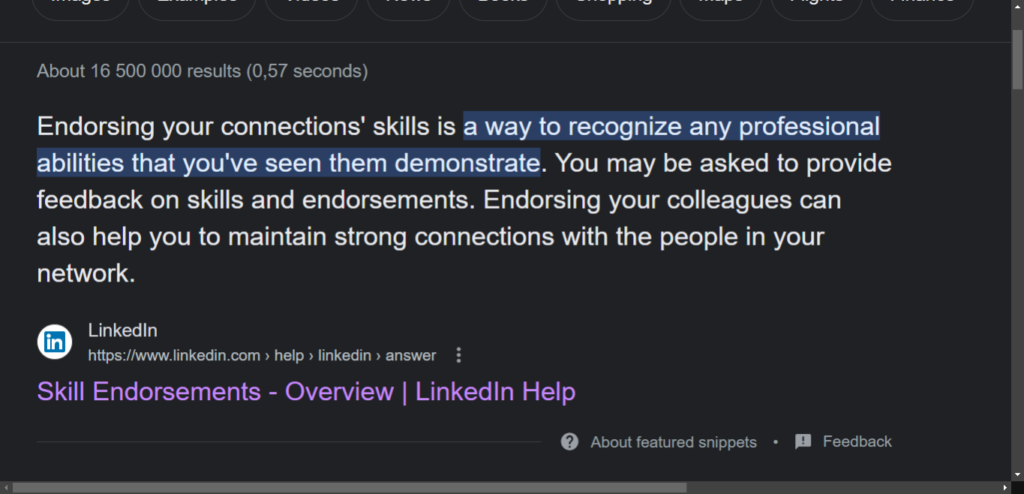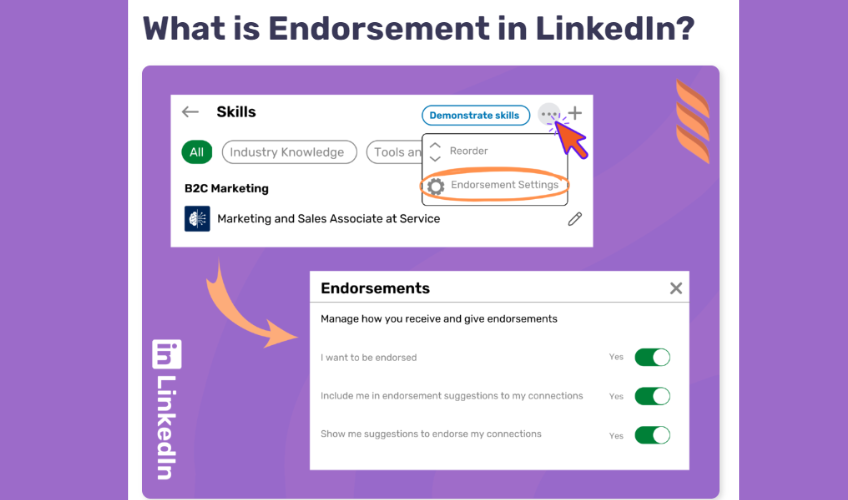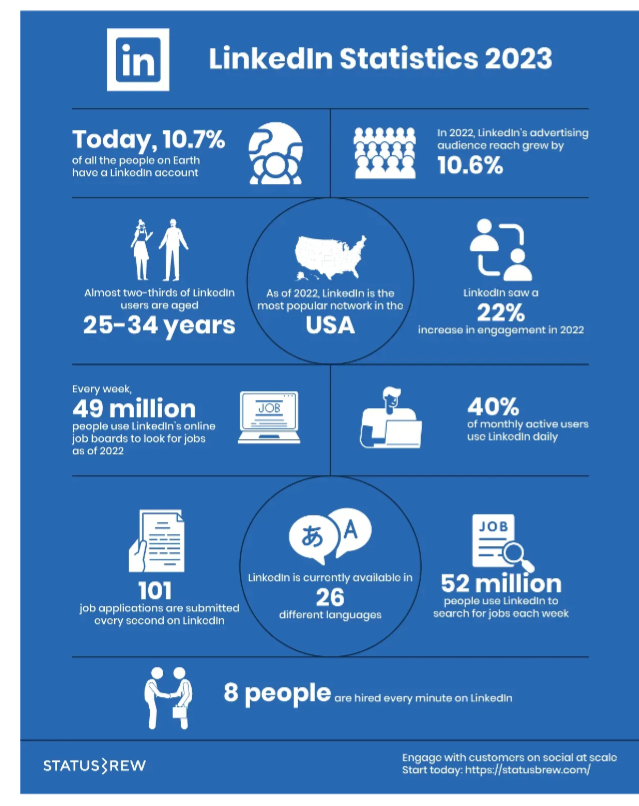LinkedIn is the professionals’ choice for online networking, and a bit part of that is endorsements.
In fact, they’re one of the most effective ways to prove your expertise and back up your claims.
Anyone can say they possess a particular skill, but having 99+ endorsements proves that.
We’ll use a case study of a popular LinkedIn member to highlight the best practices for gaining some much-needed profile engagement.
What are endorsements?
Before we go any further, we’ll explain this concept if you’re unfamiliar.
It’s pretty simple.
Endorsements are a LinkedIn feature that allows others to verify your skills with a single click.
Here’s a screenshot of the formal definition given by LinkedIn:

For instance, the top three skills on this profile are SEO, online marketing, and web analytics.

Endorsements are a simple way to prove you are not a charlatan — you’re genuinely proficient at the skills you list on your profile.
The more endorsements you have, the more legit you appear.
Ideally, you’ll want to reach 99+.
See?

Here too:

All are 99+.
Of course, you can have thousands of endorsements for a certain skill, but 99+ is the highest number that will appear unless someone actually clicks on the skill to dig deeper.
Here’s what we’re talking about:

LinkedIn users had 2,134 endorsements for SEO, but 99+ is what visitors first see.
Why are endorsements important?
Getting people to endorse you can open doors and unlock opportunities that might not have happened otherwise.
It’s a way to validate yourself and show you really do have the chops.
This appeals to those who come across your LinkedIn profile, looking to find a partner in a business project, working arrangement, etc.
Some experts even suspect it can impact your search ranking.
The bottom line is the more endorsements you receive, the better.
In this article, we’d like to discuss some strategies to help you get 99+ endorsements on all your LinkedIn skills.
Let’s start from the top.
Prioritize your skills
Most people have a wide array of skills.
And LinkedIn is more than happy to help you share them with the world.
In fact, they allow you to list up to 50.
But you must be selective about the skills you list at the top.
As we mentioned earlier, the top three skills in this case study are SEO, online marketing, and web analytics.
This is important for two reasons.
First, getting endorsements tends to be easier when it’s for your core skills that people naturally associate you with.
For example, you might have experience with website development.
However, the user is renowned for SEO — this is their priority.
Therefore, most people associate their name with SEO more than website development, making them far more likely to endorse us for SEO.
That’s why SEO is the first skill on their profile.
Second, people tend to get overwhelmed if there is a ridiculous number of choices.
But if you place your primary skills at the top, people can zone in on those skills, increasing the likelihood of them endorsing you.
Endorse others
We’re firm believers in the law of reciprocity.

It’s a psychological principle we’ve discussed in several blog posts, mainly in the context of conversion optimization.
Long story short, it simply means that people are inclined to do something nice for you if you do something nice for them.
But reciprocity can be applied to LinkedIn endorsements as well.
And it’s not rocket science.
Endorse the skills of others, and there’s a good chance a considerable percentage of them will return the favor.
We recommend starting with the people you’re closest to and have the tightest relationships with.
This might include colleagues, team members, previous employers, and satisfied customers/clients.
Look over the skills they list on their profiles, and add a few endorsements.
Once they see you’ve tried to help them, many will also be inclined to help you.
If they know for a fact you’re adept at a particular skill, it shouldn’t be any trouble for them to endorse you.
And the beautiful thing is it’s easy to do.
It’s not like it requires a major time commitment.
Unlike personal recommendations that require someone to write a unique statement, an endorsement requires only a single click.
It’s really no big deal.
Straight-up ask for endorsements
One thing we’ve learned in life, as well as in business, is that it’s important to ask.
Some of our biggest breakthroughs simply resulted from asking for help, a favor, etc.
And you know what?
A lot of people are more than willing to help you out.
Tactic #1
If you want to raise your number of endorsements quickly, we suggest politely asking others to give them to you.
An article on LinkedProspect discusses a specific formula for increasing endorsements by asking.
It’s simple.
The author, Scott, created a brief message that he sent to 300 connections asking for endorsements.
Here’s what it looked like:

We’d like to point out his opening line:
What skills do you want to be endorsed for?
We think this is a more effective way to approach people than immediately asking for an endorsement—it doesn’t make you come across as overly self-serving.
After sending this message to 300 connections, Scott saw a drastic increase in his number of endorsements.
It went from a meager 28 to 302, which was an increase of over 1,000%!


The amazing thing is that it took less than 15 minutes.
Tweak this template as you see fit, and send it to as many connections as possible.
While you may not get quite the level of results that Scott did, we’re confident that you’ll see a substantial spike in your number of endorsements.
Tactic #2
Here’s another simple way to go about asking.
It involves leveraging existing resources where people understand your skillset and know what you bring to the table.
Some examples might include your blog and email.
Here’s what you do.
First, invite others to connect with you on LinkedIn.
This is necessary because the last time we checked, only first-degree connections are allowed to endorse you.
To do this, you could leave a CTA with a link to your LinkedIn account at the end of blog posts or in your email signature.
Then, each time you make a new connection, send them the message we discussed in the previous tactic.
Be active on LinkedIn
One of the things we find interesting about LinkedIn is that many people seldom update their profiles.
While there are 930 million global users, with 40% visiting LinkedIn daily.
Most people update their Facebook at least two or three times a week.
It’s usually the same with Instagram profiles.
As for Twitter, it’s not uncommon to hit double-digit updates daily.
But for some reason, people don’t post as much on LinkedIn.
Ideally, you’ll update your feed frequently:

And for a good reason.
The more often we update, the more we’re on the radar of our connections.
This means more profile traffic and more opportunities for engagement, including endorsements.
We’re trying to say that you should make a point to consistently update your LinkedIn profile with quality content.
It doesn’t even need to be your own content.
Curated content is totally fine as long as it offers real value and scratches your connections’ collective itch.
When you’re choosing what type of content to post, try to make sure it’s relevant to the primary skills you’re seeking endorsements for.
If conversion optimization is your thing, you might want to post something from ConversionXL.
Considering the small number of people posting updates on LinkedIn, it should be fairly easy for you to gain users’ attention when they scroll through their feeds.
Conclusion
When it comes to professional networking, LinkedIn is the go-to network.
While it doesn’t get as much attention or have the same user base as Facebook, Instagram, or Twitter, you don’t want to overlook it.

In fact, it’s been an incredibly powerful tool that has helped us make several valuable connections over the years.
One of the ways you can prove you’re legitimately proficient at the skills you list is by having others vouch for you by giving endorsements.
It’s quick and easy but can tremendously impact your personal brand, especially if you can gain 99+ endorsements.
Using these strategies, you can effectively leverage your network to get the endorsements you seek.
And who knows what opportunities this will lead to in the future…
The long-term implications can be profound.
